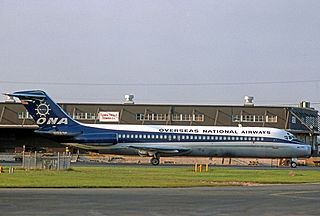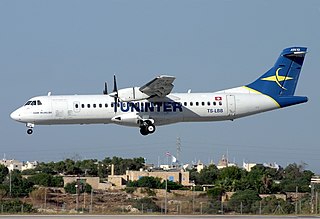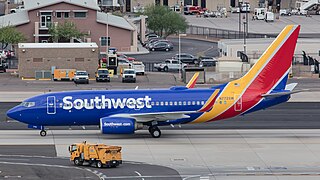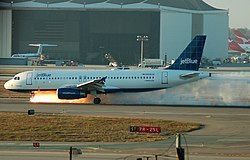
Saudia, formerly known as Saudi Arabian Airlines, is the flag carrier of Saudi Arabia, based in Jeddah. The airline's main hub is at King Abdulaziz International Airport in Jeddah and King Khalid International Airport in Riyadh.

Air Canada Flight 143, commonly known as the Gimli Glider, was a Canadian scheduled domestic passenger flight between Montreal and Edmonton that ran out of fuel on Saturday, July 23, 1983, at an altitude of 41,000 feet (12,500 m), midway through the flight. The flight crew successfully glided the Boeing 767 to an emergency landing at a former Royal Canadian Air Force base in Gimli, Manitoba, which had been converted to a racetrack, Gimli Motorsports Park. It resulted in no serious injuries to passengers or persons on the ground, and only minor damage to the aircraft. The aircraft was repaired and remained in service until its retirement in 2008. This unusual aviation incident earned the aircraft the nickname "Gimli Glider."
A deadstick landing, also called a dead-stick landing, is a type of forced landing when an aircraft loses all of its propulsive power and is forced to land. The "stick" does not refer to the flight controls, which in most aircraft are either fully or partially functional without engine power, but to the traditional wooden propeller, which without power would just be a "dead stick". When a pilot makes an emergency landing of an aircraft that has some or all of its propulsive power still available, the procedure is known as a precautionary landing.

British Airways Flight 009, sometimes referred to by its callsign Speedbird 9 or as the Jakarta incident, was a scheduled British Airways flight from London Heathrow to Auckland, with stops in Bombay, Kuala Lumpur, Perth, and Melbourne.

Gimli Industrial Park Airport is a civilian airport and former military field located 2 nautical miles west of Gimli, Manitoba, Canada.

TACA Flight 110 was a scheduled international airline flight operated by TACA International Airlines, traveling from San Salvador to New Orleans, with a stopover in Belize City. On May 24, 1988, the flight encountered severe thunderstorm activity on its final approach to New Orleans International Airport. As a result, the brand new Boeing 737-300 suffered flameout in both engines while descending through a severe thunderstorm, but the pilots made a successful emergency landing on a grass levee adjacent to NASA's Michoud Assembly Facility, with no one aboard sustaining more than a few minor injuries, and with only minor hail damage to the intact aircraft. Following an on-site engine replacement, the jetliner took off from Saturn Boulevard, a road which had previously been an aircraft runway at Michoud. The aircraft was subsequently repaired and returned to service until it finally retired in 2016.

In aviation, a water landing is, in the broadest sense, an aircraft landing on a body of water. Seaplanes, such as floatplanes and flying boats, land on water as a normal operation. Ditching is a controlled emergency landing on the water surface in an aircraft not designed for the purpose, a very rare occurrence. Controlled flight into the surface and uncontrolled flight ending in a body of water are generally not considered water landings or ditching.

Falling from the Sky: Flight 174 is a 1995 Canadian thriller film directed by Jorge Montesi. Based on the events of Air Canada Flight 143, the film stars William Devane, Scott Hylands, Shelley Hack and Mariette Hartley. Set in 1983, the film follows the crew, their families and the passengers of the flight, from the preparations for departure to the emergency landing on an abandoned airfield in Manitoba, and everything in between.

In an internal combustion engine, fuel starvation is the failure of the fuel system to supply sufficient fuel to allow the engine to run properly, for example due to blockage, vapor lock, contamination by water, malfunction of the fuel pump or incorrect operation, leading to loss of power or engine stoppage. There is still fuel in the tank(s), but it is unable to get to the engine(s) in sufficient quantity. By contrast, fuel exhaustion is an occurrence in which the vehicle in question becomes completely devoid of usable fuel, with results similar to those of fuel starvation.
The article describes accidents and incidents on Korean Air and its predecessor companies Korean National Airlines and Korean Air Lines.

ALM Antillean Airlines Flight 980 was a flight scheduled to fly from John F. Kennedy International Airport in New York City to Princess Juliana International Airport in St. Maarten, Netherlands Antilles, on May 2, 1970. After several unsuccessful landing attempts, the aircraft's fuel was exhausted, and it made a forced water landing in the Caribbean Sea 48 km off St. Croix, with 23 fatalities and 40 survivors. The accident is one of a small number of intentional water ditchings of jet airliners.

China Airlines Flight 605 was a daily non-stop flight departing from Taipei at 6:30 a.m. and arriving at Kai Tak Airport in Hong Kong at 7:00 a.m. local time. On November 4, 1993, the plane went off the runway and overran while landing during a storm. It was the first hull loss of a Boeing 747-400.

Tuninter Flight 1153 was a Tuninter Airlines international flight from Bari International Airport in Bari, Italy, to Djerba-Zarzis Airport in Djerba, Tunisia. On 6 August 2005, the Tuninter ATR 72 ditched into the Mediterranean Sea about 18 miles (29 km) from the city of Palermo. Sixteen of the 39 people on board died. The accident resulted from fuel exhaustion due to the installation of fuel quantity indicators designed for the ATR 42 in the larger ATR 72. It was also Tuninter's first fatal accident in the 14-year history of the company.
Several aviation incidents and accidents have occurred in which the control surfaces of an aircraft became disabled, often due to failure of hydraulic systems or the flight control system. Other incidents have occurred where controls were not functioning correctly prior to take-off, either due to maintenance or pilot error, and controls can become inoperative from extreme weather conditions. Aircraft are not designed to be flown in such circumstances; however, a small number of pilots have had some success in flying and landing aircraft with disabled controls.

Southwest Airlines Flight 1380 was a Boeing 737-700 that experienced a contained engine failure in the left CFM International CFM56 engine after departing from New York–LaGuardia Airport en route to Dallas Love Field on April 17, 2018. The engine cowl was broken in the failure, and cowl fragments damaged the fuselage, shattering a cabin window and causing explosive depressurization of the aircraft. Other fragments caused damage to the wing. The crew carried out an emergency descent and diverted to Philadelphia International Airport. One passenger was partially ejected from the aircraft and sustained fatal injuries, while eight other passengers sustained minor injuries. The aircraft was substantially damaged.













